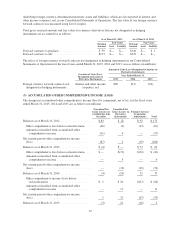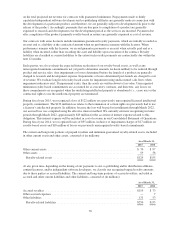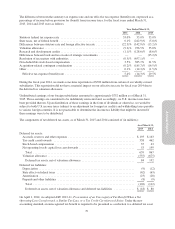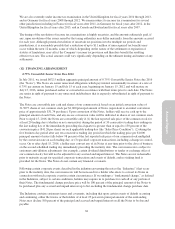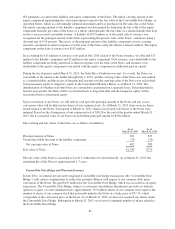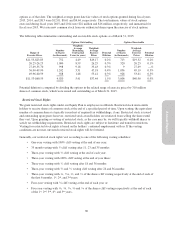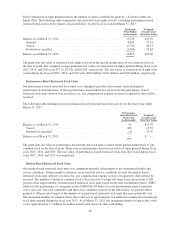Electronic Arts 2015 Annual Report Download - page 150
Download and view the complete annual report
Please find page 150 of the 2015 Electronic Arts annual report below. You can navigate through the pages in the report by either clicking on the pages listed below, or by using the keyword search tool below to find specific information within the annual report.
if the disallowance of the uncertain tax position would reduce an available tax loss or tax credit carryforward
instead of resulting in a cash tax liability. The ASU applies prospectively to all unrecognized tax benefits that
exist as of the adoption date. Prior to adoption, the deferred tax assets were presented without reduction for
uncertain tax positions.
The valuation allowance decreased by $120 million in fiscal year 2015, primarily due to the current fiscal year
utilization of U.S. deferred tax assets. We have not yet been able to establish a sustained level of profitability in
the U.S. or other sufficient significant positive evidence to conclude that our U.S. deferred tax assets are more
likely than not to be realized. Therefore, we continue to maintain a valuation allowance against most of our U.S.
deferred tax assets. It is possible that a significant portion of the valuation allowance recorded against our U.S.
deferred tax assets at March 31, 2015 could be reversed by the end of fiscal year 2016.
As of March 31, 2015, we have state net operating loss carry forwards of approximately $785 million of which
approximately $114 million is attributable to various acquired companies. These carry forwards, if not fully
realized, will begin to expire in 2016. We also have U.S. federal, California and Canada tax credit carry forwards
of $320 million, $131 million and $7 million, respectively. The U.S. federal tax credit carry forwards will begin
to expire in 2024. The California and Canada tax credit carry forwards can be carried forward indefinitely.
The total unrecognized tax benefits as of March 31, 2015 and 2014 were $254 million and $232 million,
respectively. A reconciliation of the beginning and ending balance of unrecognized tax benefits is summarized as
follows (in millions):
Balance as of March 31, 2013 ............................................................. $297
Increases in unrecognized tax benefits related to prior year tax positions ......................... 10
Decreases in unrecognized tax benefits related to prior year tax positions ........................ (79)
Increases in unrecognized tax benefits related to current year tax positions ....................... 44
Decreases in unrecognized tax benefits related to settlements with taxing authorities ............... (29)
Reductions in unrecognized tax benefits due to lapse of applicable statute of limitations ............. (9)
Changes in unrecognized tax benefits due to foreign currency translation ........................ (2)
Balance as of March 31, 2014 ............................................................. 232
Increases in unrecognized tax benefits related to prior year tax positions ......................... 9
Decreases in unrecognized tax benefits related to prior year tax positions ........................ (14)
Increases in unrecognized tax benefits related to current year tax positions ....................... 50
Decreases in unrecognized tax benefits related to settlements with taxing authorities ............... (6)
Reductions in unrecognized tax benefits due to lapse of applicable statute of limitations ............. (7)
Changes in unrecognized tax benefits due to foreign currency translation ........................ (10)
Balance as of March 31, 2015 ............................................................. $254
A portion of our unrecognized tax benefits will affect our effective tax rate if they are recognized upon favorable
resolution of the uncertain tax positions. As of March 31, 2015, approximately $58 million of the unrecognized
tax benefits would affect our effective tax rate and approximately $195 million would result in adjustments to
deferred tax valuation allowance. As of March 31, 2014, approximately $84 million of the unrecognized tax
benefits would affect our effective tax rate and approximately $148 million would result in corresponding
adjustments to the deferred tax valuation allowance.
Interest and penalties related to estimated obligations for tax positions taken in our tax returns are recognized in
income tax expense in our Consolidated Statements of Operations. The combined amount of accrued interest and
penalties related to tax positions taken on our tax returns and included in non-current other liabilities was
approximately $16 million as of March 31, 2015 and 2014. There is no material change in accrued interest and
penalties during fiscal year 2015.
We file income tax returns in the United States, including various state and local jurisdictions. Our subsidiaries
file tax returns in various foreign jurisdictions, including Canada, France, Germany, Switzerland and the United
Kingdom. The IRS is currently examining our returns for fiscal years 2009 through 2011, and we remain subject
to income tax examination by the IRS for fiscal years after 2011.
80




